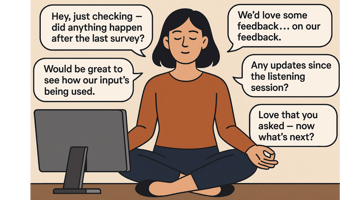If you're running out of ideas for team building and wondering how you could foster more altruistic...
When “get resilient” really means “get over it”
Picture this: you’re drowning in emails, sprinting between meetings like a caffeinated bunny, and your boss announces a new Resilience Program. Cue the inspirational poster of a lone climber, the mindfulness webinar at 7 a.m., and the stress‑ball branded with company values. Ta‑da! Problem solved, right?
Except it isn’t. Because the real problem is still squatting on your to‑do list like a sumo wrestler: too much work, not enough runway.

The wellness‑washing of workload
Resilience initiatives feel virtuous (and, let’s be honest, look fabulous in the CSR report), but they often morph into a polite way of saying “Here’s a yoga link, now go bend yourself around the impossible.”
It’s no coincidence that global engagement slid again this year, from 23 % to 21 % according to Gallup’s 2024 State of the Global Workforce. Manager burnout is cited as a key driver. Financial Times
Translation? Even the people paid to paste on a brave face are cracking. In other words, the kombucha keg in reception isn’t fooling anyone. Although, sidenote; I do love a good kombucha - but I digress...
Workload: the elephant tap‑dancing on your desk
Let’s zoom out. A 2024 Deloitte survey found 61 % of employees felt burned out in the past year; 46 % blamed plain old workload. Feelance
Burnout isn’t cheap either: lost productivity, absenteeism and turnover vacuum up as much as $300 billion a year worldwide, and projections hit $6 trillion by 2030 if we keep flogging the same tired horses. Worldmetrics
If your finance team needs a business case to take workload seriously, there it is, complete with a bow and a flaming hole in the profit‑and‑loss statement.
Humans are not hard drives (we don’t upgrade to “Capacity 2.0”)
Employees have roughly 1,440 minutes in a day. Take away sleep, commuting, and the time it takes to remember all 17 different passwords, and you’re left with… not enough.
Resilience programs suggest people can simply stretch indefinitely, like your favourite leggings, only without the lycra. In reality, piling wellbeing tips atop an overflowing plate just increases the guilt: “I’m failing at workload and yoga.”
Fix the system, not the symptom
-
Start with an audit, not an affirmation
Map real vs. assumed capacity. Where does work bottleneck? Which meetings deserve a Viking funeral? -
Resource like you mean it
Headcount isn’t a dirty word. If budgets are frozen, rejig priorities; stop promising “everything, everywhere, all at once.” -
Streamline processes
Automate the robotic tasks so humans can do the human ones (creativity, problem‑solving, gossiping about Squid Game - Season 2). -
Kill or cure your tech stack
Ten overlapping tools don’t equal efficiency; they equal ten places to lose the will to live. -
Measure capacity, not just charisma
Managers must be rewarded for realistic scoping, not heroic all‑nighters. Otherwise you’ve institutionalised burnout as a KPI.
What good looks like
-
Workload transparency dashboards; show what’s on whose plate in real time.
-
Quarterly “Stop Doing” reviews; if a task doesn’t add value, axe it cheerfully.
-
Embedded recovery time; protect no‑meeting blocks or true flex hours; guard them like the last cookie at the bake sale.
-
Shared metrics; tie wellbeing to operational KPIs so finance cheers when stress drops.
When organisations tackle workload head‑on, wellbeing improves as a by‑product, not an after‑thought. Employees don’t need yoga classes to survive a sane schedule, they need a sane schedule.
Mic‑drop conclusion
Handing out resilience toolkits while workloads mushroom is like giving firefighters extra water bottles instead of fixing the broken hydrant. Stop sprinkling lavender oil on a stinky rubbish-tip fire.
Address the real blaze! Capacity, resources, systems, processes, and watch resilience blossom naturally. Spoiler alert: people thrive when they’re not parked perpetually in the red zone.
So next time someone suggests another “Be Your Best Self” webinar, smile warmly and ask, “Great idea, what work are we dropping to make space for it?”
That, my friends, is resilience worth applauding.
Actions you can take now 👇
Want to check-in on how your organisation rates on the Workload Balance scale? - Do the mini survey and get a personalised report.
Keen to run a Workload & Wellbeing workshop with your team to show you're proactive in this space? Get the DIY Workshop for this topic and start taking action.




-1.png?height=200&name=Ruthless%20Prioritisation%20LI%20(1)-1.png)